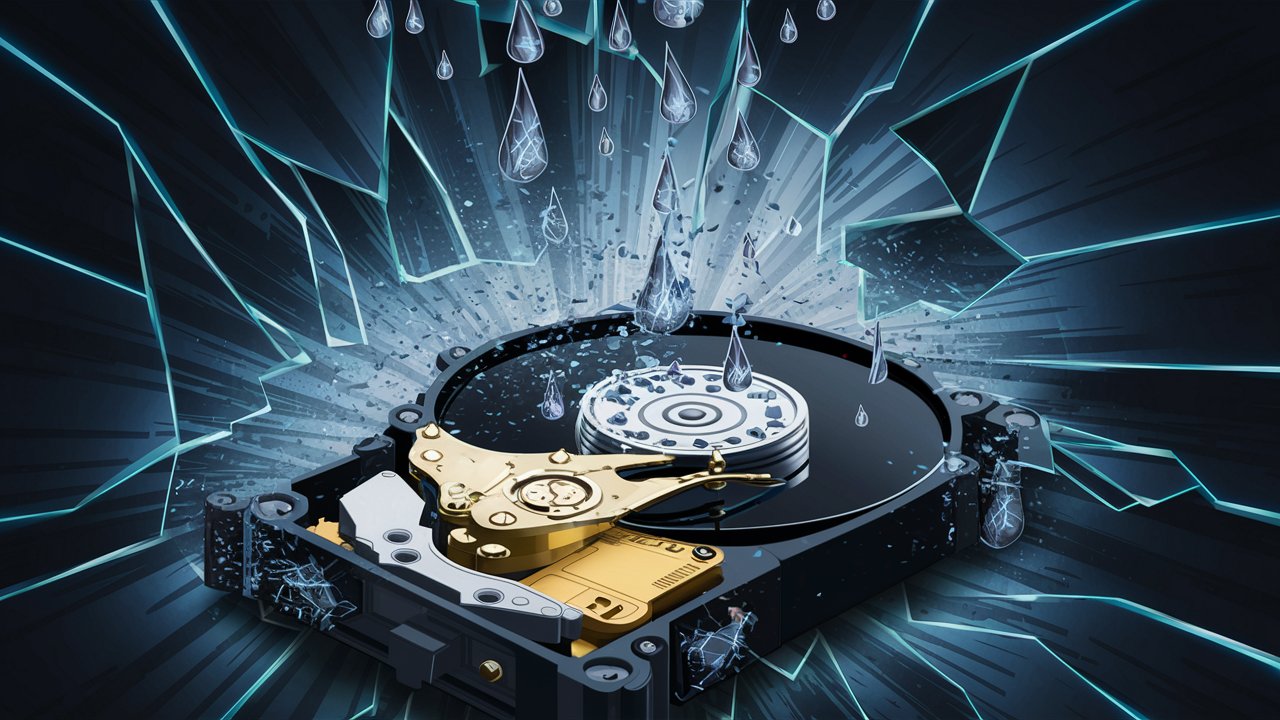Intro
Have you ever considered the impact of a simple drop can have on your hard drive? The consequences of drops and impact can be severe, leading to permanent data loss due to hard drive damage. In this blog post, we will delve into the vulnerabilities of hard drives, how drops and impacts cause damage, the path to permanent data loss, real-world examples of data loss from physical damage, preventative measures to protect your data, what to do if your hard drive suffers a drop or impact, and the future of data storage and physical durability.

The Structure of a Hard Drive and Its Vulnerabilities
Delving into the anatomy of a hard drive illuminates why they are so prone to damage upon experiencing drops and impacts. At the heart of a hard drive are its platters: precise, flat discs coated with magnetic material where your data lives. Hovering just nanometers above these platters are the read/write heads, which are tasked with interpreting and writing your data. These components, along with the spindle motor that spins the platters at thousands of revolutions per minute, exist in a delicate equilibrium.
This fragile balance is what makes hard drives particularly susceptible to physical trauma. A sudden jolt or a drop doesn't merely pose a risk; it disrupts the precise choreography required for data storage and retrieval. For instance, even a minor impact can cause the read/write heads to touch or scratch the platter surfaces, a scenario similar to a figure skater's blade nicking the ice, leaving irreparable damage in its wake. Likewise, the spindle motor and the alignment of the platters can suffer, hindering the hard drive's ability to operate smoothly.
Given this intricate interplay of components, it's clear that the physical integrity of a hard drive is paramount. Any deviation, no matter how slight, can be the precursor to data access issues or, more gravely, complete data loss. This vulnerability underscores the importance of handling these devices with the utmost care to safeguard the valuable data they hold.

How Drops and Impacts Cause Damage
Understanding the mechanism by which drops and impacts inflict harm on hard drives is essential to grasp the seriousness of these incidents. Essentially, when a hard drive is subjected to a significant force, such as a fall or a blow, it can lead to a cascade of internal disruptions. These disruptions might include the read/write heads, which are integral for data retrieval and storage, being forcibly misaligned or making contact with the platters, an event that can be as detrimental as a surgeon's scalpel slipping during a delicate operation. This unwanted contact can cause scratches on the platters that are similar to scars on the surface, marring the data stored there and rendering it irretrievable.
Further, such impacts can jostle the internal components to such a degree that the spindle motor, responsible for the platters' rotation, might suffer damage. This can compromise the hard drive's ability to spin up and function, leading to a failure to access the stored data. These scenarios highlight the inherent risks that physical forces pose to the delicate internal equilibrium of hard drives, showcasing how crucial it is to shield these devices from physical trauma to avoid the devastating journey toward permanent data loss.

The Path to Permanent Data Loss Due to Drops and Impact
The journey toward permanent data loss initiated by drops and impact begins subtly, often masking the severity of its eventual outcome. At first, the inflicted damage might appear benign, manifesting as irregular difficulties in accessing or retrieving data. It's similar to a minor wound on the skin that, without proper care, can develop into a more serious infection. Over time, these seemingly insignificant issues can compound, exacerbating the hard drive's condition. Each attempt to read from a damaged sector or a failed spin of the misaligned spindle motor can lead to further internal harm. This degradation process is not immediate; it's a slow burn that, if not addressed promptly, culminates in the hard drive's complete incapacity to function. The culmination of this degradation is the grim reality of permanent data loss, where the data once thought safe and secure becomes irretrievably lost to the void. This progression from initial impact to total data erasure highlights a critical window of opportunity for intervention that, if missed, seals the fate of the data housed within the compromised hard drive.

Real-World Examples of Data Loss from Physical Damage
In exploring the tangible impact of physical damage on data storage, several stories come to the fore, illustrating the grave consequences of neglecting to protect hardware from drops and impacts. A common scenario involves an individual accidentally dropping their external hard drive while attempting to connect it to their computer. Despite the external casing showing minimal damage, the internal components suffer, leading to an inability to access years of personal photos and documents. In a corporate setting, an office relocation results in a server being improperly secured during transport. Upon arrival, the server exhibits failure to boot, with diagnostics revealing severe platter damage due to impact. This incident not only stops business operations but also results in the loss of critical financial data. These real-world examples underscore the fragility of digital storage mediums and the profound effects physical trauma can have on data accessibility. They serve as stark reminders of the importance of handling storage devices with care and taking proactive steps to mitigate the risks of physical damage.

Preventative Measures to Protect Your Data
In the realm of protecting your digital treasures, proactive steps are paramount. Think of protective measures as a suit of armor for your hard drive, guarding against the perils of accidental drops and impacts. Start by investing in a robust protective case, an essential shield that can absorb shock and mitigate potential damage. When it comes to transportation or simply shifting your device from one location to another, securing your hard drive firmly ensures that it remains untouched In the middle of the journey’s unavoidable jostles and bumps. Beyond the physical realm, establishing a consistent backup routine acts as an essential safety net. By duplicating your data onto an external source, you create a fail-safe, ensuring that even in the face of physical calamity, your data remains accessible and intact. This dual approach of physical protection and data duplication forms a comprehensive defense strategy, significantly diminishing the risks posed by physical trauma and preserving the integrity of your digital legacy.
What to Do If Your Hard Drive Suffers a Drop or Impact
If your hard drive experiences the unfortunate fate of a drop or impact, the initial steps you take can be critical in averting the specter of permanent data loss. The immediate action should be to remove the power source from the affected device. This preemptive measure is similar to applying a tourniquet, aiming to halt further complications before they grow into permanent damage.
After that, the environment becomes one that is best managed by someone with professional experience. The point at which expert intervention is no longer simply helpful but also required must be identified. Speaking with a data recovery specialist might be a ray of hope in an otherwise hopeless circumstance. These experts, who have the same resources and training as surgeons when it comes to data recovery, will perform a comprehensive evaluation of the damage. Their assessment becomes the basis for developing a customized recovery plan that aims to recover what is still available in the middle of the impact's chaos.
It's important to underscore the role of patience and restraint during this period. The urge to power on the device and check for data integrity might be overwhelming but resisting this impulse is crucial. Any unauthorized attempts to access or recover the data might intensify the existing damage, thereby narrowing the window of opportunity for professional recovery services to work their magic effectively. In the delicate dance of data recovery, precision, and professional insight are your most reliable partners.

The Future of Data Storage and Physical Durability
In the future, data storage technology is headed toward innovations that will greatly increase these devices' resilience to physical catastrophes. The unrelenting quest for more durable storage media is paving the way for a time when fears of data loss from drops and impacts will become a thing of the past. Cutting-edge materials and architectures are being used by industry leaders to include durability in storage device designs, which promise to lessen the impact of unintentional maltreatment. Imagine hard drives that can repair themselves or made of materials that absorb stress more quickly, protecting the valuable data inside from the effects of unexpected knocks. Furthermore, the development of solid-state drives (SSDs) provides insight into a future in which devices that are more resilient to physical stress will be possible due to the elimination of moving parts, which are the conventional cause of hard drive vulnerability. In an increasingly data-driven society, data storage might become more than simply a storehouse of knowledge thanks to this technological advancement; it could also serve as a stronghold against unanticipated events, guaranteeing the endurance and security of our digital legacy.